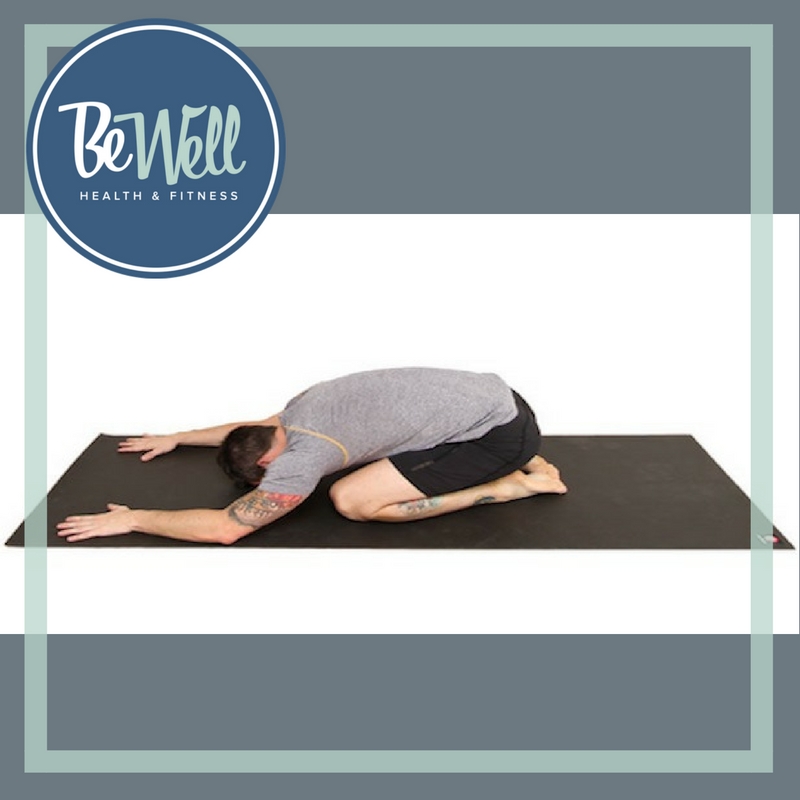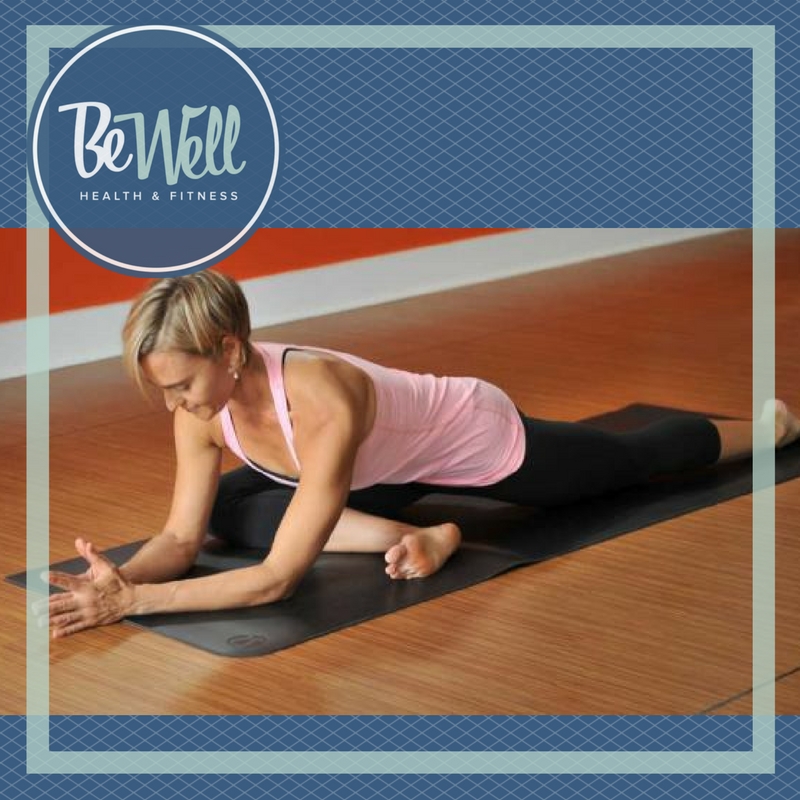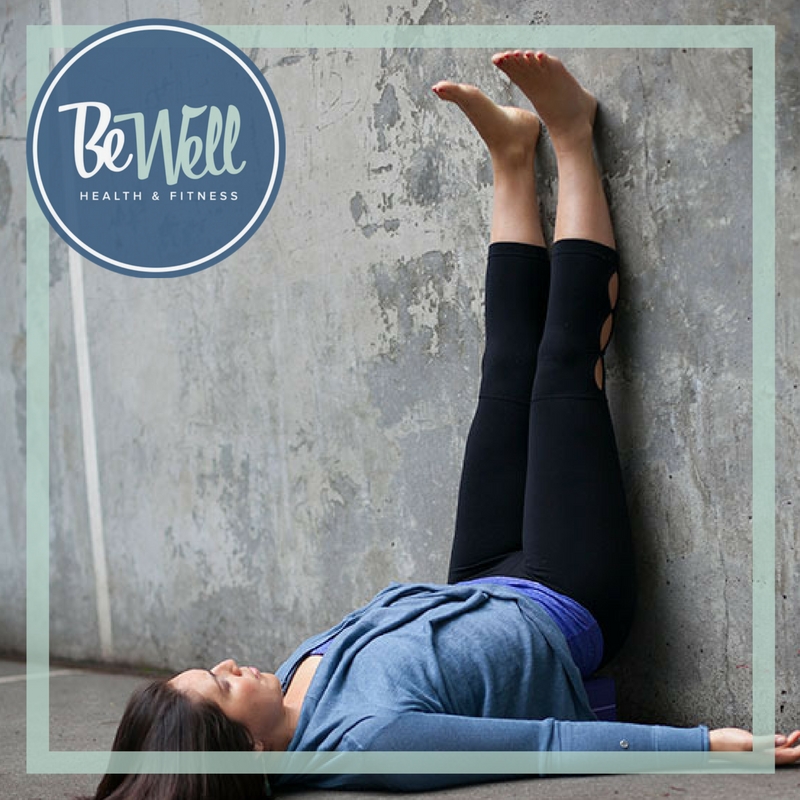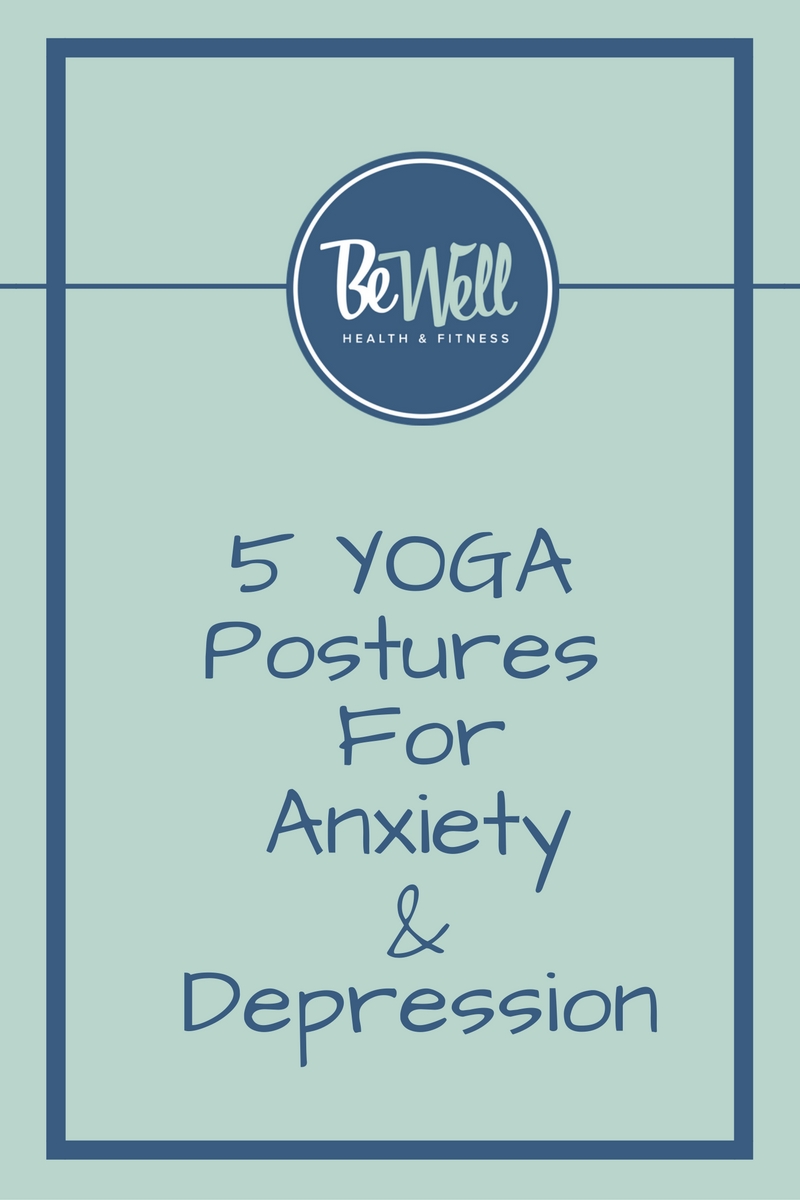Child’s Pose (Balasana)
How To Do It:
- Start in a table-top position (hands and knees… shoulders over wrists… hips over knees)
- Bring your big toes together behind you and bring your knees out a little wider (toward edges of the mat)
- Walk your fingers forward (toward the top of your mat)
- Rest your forehead (or as yogis like to call the space between your eyebrows “The third eye”) on the mat.
- Breathe.
*Modify:
Harder:
Reach the hands forward and rest your chest on the mat as you gently press the tailbone toward the heels.
Easier:
Walk the knees closer together or rest head and torso on a pillow or bolster.
*option to bring hands by your sides reaching towards your feet
Why It Works:
Releases muscles the neck, shoulders, upper back, hips, thighs, and signals a “You’re safe!” message to the brain. Reminds you to taking time in your life to rest is a good thing!

Half Pigeon (Eka Pada Rajakapotasana)
How To Do It:
- Start in a Downward Facing Dog pull right** knee forward and line up your right** ankle with your left** wrist (the right foot might slide in closer to the body as you lower.. That’s OK!.. but try and keep the hips squared to the front and the right foot flexed).
- Take the hands to the floor by your sides to help square the hips forward (but avoid hunching the shoulders).
- Keep the right** foot flexed and begin to lift the torso up and forward, folding over the bent leg.
- Rest hands or forearms on the mat.
- Stay here for 6-10 deep breaths (Yes, in yoga… we time everything with breaths… yogis are funny like that- winky face 😉
- Repeat on the other side
(Reverse the use of “Right” and “Left” to uncover the secrets of the other side)**
*Modify:
Harder:
Reach the right** arm forward and thread the left** arm under the right…. Then find a PRAYER TWIST (palms stack, right** on top of left**). Look toward your right** elbow.
Easier:
If you have stiff hips or an injury, or just don’t want to do it…..Try “Reclined Half- Pigeon” on your back. (See Below)
1.Lay on your back
2.Bend your left** leg (foot on the earth/knee to the sky)
3.Place your right** ankle on your left thigh
Why It Works:
Relieves tension in the hips, which is thought to release emotional stress stored from recurring stress.

Legs Up the Wall (Viparita Karani)
How To Do It:
- Lay on your side with your left hip on the floor in front of a wall, with your legs extended to 90 degrees (like you are sitting on the wall..). (For added comfort try using a blanket under the tailbone… just lay it folded up against the wall first)
- Roll onto your back and rotate your feet up the wall. (you might have to use your hands to scoot you closer to the wall… there should be minimal gap between you and the wall)
- Stay here for a while, close your eyes and just observe your breath.
*Modify:
Harder:
Place a blanket, block, or big book under the tailbone to enhance the degree of inversion.
Easier:
Move farther away from the wall.
Why It Works:
This is what yogi-friends like to refer to as the “Cure-All” asana.
- Regulates blood flow
- Alleviates menstrual cramps
- Relieves swollen ankles and varicose veins
- Helps testicular, semen, and ovarian problems in men and women respectively
- Improves digestion
- Restores tired feet or legs
- Stretches the back of the neck, front torso, and back of the legs
- Relieves back pain
- Headache relief
- Relieves symptoms of mild depression and insomnia
- …….ANNNNNNND Calms anxiety

Tree Pose (Vrikasana)
How To Do It:
- Start standing with palms together in front of your heart.
- Close your eyes and take a few calming breaths to center the mind.
- Open your eyes and fix your gaze on a non-moving object in front of you (look for something eye level)
- Shift your weight into your right** foot and step the sole of your left foot to the calf muscle of your right** leg. (be sure to ground down equally between all 4 corners of the right** foot to maintain balance
- Square your shoulders and hips to the front
- Lift your hands overhead, part the palms, and gently draw the shoulder blades down the back.
- Stay here for 4-6 breaths.
*Modify:
Harder:
Bring the left** foot to the right** inner thigh
Even Harder:
Close your eyes
Easier:
Step the ball of the left** foot to the inside of the right** ankle (Create a little “Kickstand” for added support)
Why It Works:
Mirrors the mental effects of finding balance in the physical body.

Corpse Pose (Savasana)
How To Do It:
- Start laying on your back with your arms and legs extended long
- Bring your heels out wider than your hip points (close to the outer edges of your yoga mat)
- Allow the toes to drop open wider than the heels (notice the hips relax)
- Slide the hands out about 6 inches away from your hips (Palms face the sky)
- Roll one shoulder under and then the other (opening the chest)
- Allow the entire body to relax and find the natural rhythm of your breath
- Let the mind relax by simply observing the breath as it flows in and out of the lungs at its natural pace
- Stay here for at least 4 mins allowing the body to reset and restore.
*Modify:
Too much pressure for the low back?
Place a bolster or pillow under your knees for support
To open the hips and inner thighs more?
Bring the soles of the feet together, letting the knees splay out to the sides with blocks or blankets supporting the knees/thighs
Why It Works:
After the exertions of the practice, Corpse Pose (Savasana) allows the body to reset and find a deep meditative state of mind. The entire body will have been stretched, contracted, twisted and inverted during during class and this pose assures that even the deepest muscles will have the opportunity to let go and shed their regular habits, if only for a few minutes.

